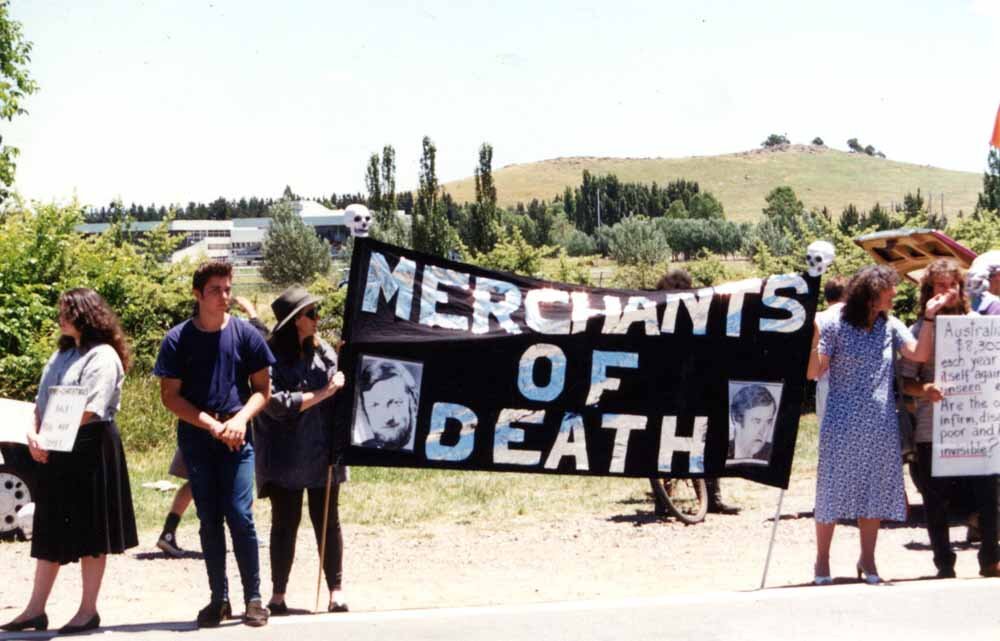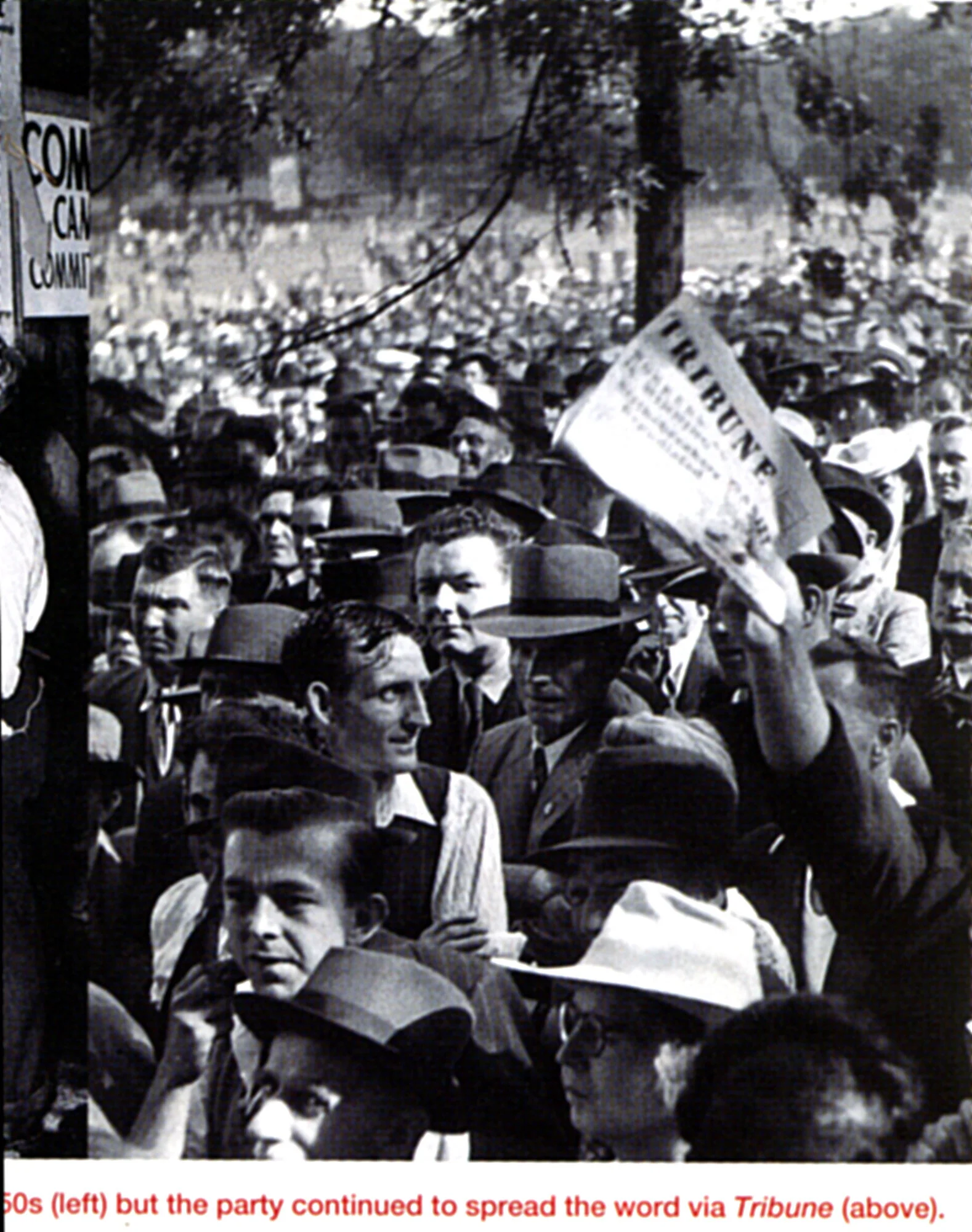
The Cold War deepens
and extends into
every corner
of Australian thinking

1950s
Korean War
Referendum on the legality of the Communist Party
British Atomic Testing
Cold War
Hungary
Attack on Unions
Communist office in Woolloomooloo
vandalised
in the 1950s
An outcome of the intense
anti-communist propaganda from the Government and other forces
In the Domain
The CPA took to public speaking to get the message out. Here is part of the crowd at the Domain, Sydney, on a typical Sunday afternoon
Korean War 1950-1953
The Prime Minister of the time Bob Menzies wanted to send Australian troops to the war even though the US had sufficient to wage the war. The reason behind Menzies’ move was to entice the US to be an ally of Australia so we could shelter under their nuclear umbrella.
At the end of WW2 there was only a small contigent of the RAAF in Japan that could be used for actions in Korea. Later some more troops were sent but a very small number - symbolism was the important ingredient.
“Korea gave enormous impetus to rearmament and a national security state. It provided evidence to fuel the anti-communist crusade, and the emotional reporting of the war and casualties made it easy to stigmatise any opposition as traitorous and to be eradicated.” (L. J. Louis, Menzies’ Cold War, p 15)
Referendum on the legality of the Communist Party
Menzies began the referendum to ban the Communist Party in 1951 after laws he introduced to ban the CPA were defeated in several court cases. The working class stood up to this bullying and by a combination of great efforts by the CPA and its union and other supporters, the referendum was defeated. However, the damage was done and by the end of the referendum, the Cold War had really set in. “Critics at the time and since have castigated the government for using the communist bogey as a subterfuge to cover its failure to deal with inflation; and it certainly gained enormous political advantage from kicking ‘the communist can down the road’.” ( L. J. Louis, Menzies’ Cold War, p 21 )
Publications of the fightback against the Referendum
The Communist Party took on the challenge of defeating the referendum to ban the party. The legislation was wide ranging in its attack on the human rights of all Australians, not just Communist Party members.
Pamphlet Cover
The contents show the type of Australia campaigned for by Communists and humanitarians versus the barbarism of Menzies
The Fight Against Menzies
Election Leaflet
An election leaflet used in the campaign for the 1955 Federal Election
In 1955 the CPA produced an extraordinary election leaflet with 17 pages of cartoons. It gives an idea of the bias of Menzies towards the rich and his attacks on unions, on ordinary people, his desire to wage war, and his love of the atomic bomb.
Check this link for examples of some of the cartoons click here
Hungary
The Hungarian counter revolution shook many in the Communist Party and its supporters here in Australia but the bulk of the members stayed together.
Tribune article on Hungary
British Testing of the Atomic Bomb at Maralinga
“And just as Menzies was taking the people into his confidence with “plain speaking”, he made, in absolute secrecy, one of the most momentous decisions of the Cold War. In response to a request from Prime Minister Atlee to test atomic weapons in Australia, he gave his assent without any consultation with his Cabinet. This secrecy was a feature of the Cold War, and when in September 1952 he agreed to a proposal for long term testing, again without consultation, there was further enlargement of the secret state.” (L.J. Louis, Menzies’ Cold War p 16)
The Dangers of Atomic Testing were evident in the 1950s
The Menzies Government in utmost secrecy agreed that the British could conducted atomic bomb tests despite the risks to the Australian people
Cold War - Petrov - ASIO
Mr and Mrs Petrov, a Soviet staffer and his wife from the Soviet Embassy in Canberra, defected to Australian intelligence
Cover of pamphlet
The use of the Petrov affair by the Menzies Government to attack Communism and Communists in Australia is one the worst examples of political persecution in Australian history. Here is the CPA’s rebuttal of the propaganda.
Brian Fitzpatrick described the Petrov Commission “as a political stunt to bring electoral advantage to Menzies and the Liberal Party.” He said the Petrov Commission “had very little to do with the investigation of espionage in Australia.”
“The commission lasted from May 1954 to March 1955. It heard 119 witnesses and sat for 109 days in public and 17 days in secret session.”
The Commission found that Petrov “had given certain papers to ASIO and in return had received a sum of £5,000.”
The Commission “recommended that no prosecutions of people whose activities had been investigated would be warranted.”
“…many people were seriously injured in reputation by interrogations carried on in the full glare of publicity. Given the atmosphere which existed, merely to be called as a witness was damaging, and this was compounded by extensive coverage fuelled by the free distribution of the transcripts of evidence.”
“The findings of the Commission were trivial, but other circumstances surrounding it were not. Evatt believed that the timing of the commission was determined by the political advantage which it would give to the government. Naturally Menzies denied this. But the fact that it was announced in the last hours of a Parliament which was about to dissolve for a general election six weeks hence must arouse the strong suspicion that Evatt was right.” (R Gollan, Revolutionaries and Reformists, pp 279-280)
Cold War/Class War
When Menzies "declared war on communism" it was not a figure of speech. In an onslaught more appropriate to a full scale hot war, the coercive powers of the state were extensively employed. When taxed by this extensive departure from British democratic traditions to which Menzies claimed deep attachment, the Prime Minister defence was, "Much as I love liberty, I am not prepared to concede freedom to the enemies ". The offensive was waged by means of the Crimes Act, further legislation, administrative measures, penal powers of the arbitration court, ASIO, the armed forces, and propaganda. (L.J.Louis, Menzies’ Cold War, p 41-42)
ASIO head Sir Charles Spry had a list of 16,000 who were to be immediately interned should the call from Menzies come.
“The heavy blanket of national security ideology obscured the class dimension of the Cold War. When the enemy was identified as a foreign aggressor and domestic dissent as its fifth column, the battle slogans of freedom and democracy masked the conflict of sectional interests. Some of the blanket is penetrated if a couple of questions are asked: in general, was it capital or labour that was required to make sacrifices for rearmament and for the passage through the turbulent post war transition period to the Golden Years? Any hesitation in identifying labour reflects the effectiveness of Cold War ideology in equating conflict with communism. And to apply another crude gauge, who were the domestic winners and losers in the Cold War? Again, it was capital over labour in their various manifestations. In the contest to shape post war society, despite the welfare state compromises that in fact contributed to their longer-term stability, conservatism and the champions of capitalism defeated the challenge of radicalism and soon destroyed any revolutionary alternative.” (L.J. Louis, Menzies’ Cold War, p 35)
Jim Healy
“The General Secretary of the Waterside Workers' Federation (WWF) was a high-profile member of the Communist Party, Jim Healy. He was a prime target for removal by the Groupers and ASIO who had to report that ‘Healy is acknowledged even by his opponents to be an extremely capable union leader’.” (L.J. Louis, Menzies’ Cold War, p 39)

A publication in opposition to Menzies' war on Communism

Jim Healy - famous leader of the Waterside Workers Federation in the 40s, 50s and 60s

Jim Healy's funeral

Part of the crowds who attended the funeral of Jim Healy.

Eulogy to Jim printed in the Tribune

Jim Healy talking to some workers
Who were the ‘Groupers’?
The Groupers were the organisation which formed around the late 1930s when the Catholic Church in Australia decided to support Franco’s fascist attack on the Republican Government in Spain. They opposed those in Australia who were defending the legitimate Government of Spain. In this process they became bitter enemies of the Communist Party and opposed it on many fronts over the years. They grew in power and influence during the 1940s when they developed a faction in the union movement that defeated militant initiatives and often backed the bosses. They were active in the ALP as well, promoting right wing Catholics into key positions. When the ALP leadership realised the danger presented by the Groupers and called for their expulsion, it caused a split in the ALP in 1954.
The Groupers included industrial groups, Catholic Action, the National Civic Council, the Movement, and others. Their most prominent member was BA Santamaria who had strong backing from Cardinal Mannix of Melbourne.
“Within the labour movement the source of the most consistent anti-communism and oppressive illiberalism was the Movement, operating through industrial groups. Between 1951 and mid 1953 the Movement was in the ascendant in the ALP. Evatt, whose outlook, as demonstrated over his whole career, was deeply opposed to that of the Movement, moved to the right in response to its pressures and to conciliate its leaders.” (R. Gollan, Revolutionaries and Reformists, p 277)
The Campaign against Catholic Action
The Catholic Church in Australia sided with the bosses and wealthy to undermine progressive policies put forward by the CPA and unions. They called it Catholic Action.

1960s
Vietnam War
Indigenous Land Rights
Dissension about Czechoslovakia
1963 100 members resigned under the leadership of Ted Hill and formed the Maoist influenced CPA(ML) party.
Vietnam War
8 June 1962 Announcement of 30 Army advisors going to Vietnam. They arrived in August 1962.
10 November 1964 Prime Minister Robert Menzies announces the introduction of national service to increase the army’s strength from 22,750 to 37,500. Opposition to the war in Vietnam is not accepted as a reason for exemption.
22 October 1965 A demonstration against the war in Sydney results in 65 arrests.
26 January 1966 Harold Holt succeeds Menzies as Prime Minister.
6 March 1966 Holt announces the Australian commitment in South Vietnam will be Increased to a 4,350-man task force, and will include conscripts.
8 May 1970 Anti-Vietnam War protesters stage the first moratorium marches in Australian cities — 70,000 in Melbourne and about 120,000 throughout Australia).
18 September 1970 About 100,000 people take part in a second moratorium march.
30 June 1971 Third and last of the big anti-war rallies. About 110,000 demonstrate in State capitals.
2 December 1972 Australian Labor Party elected to Government.
8 December 1972 Australia’s military commitment in South Vietnam ends, although controversy about the precise end date of the war continues.
“Hasluck, as Minister for External Affairs, said that the Government opposed peace negotiations if they involved a prior withdrawal of US troops. Implicit in this statement was the very essence of what was, and remained for the next seven years, the position of conservative Australian Governments: everything, including truth and the lives of Australian conscripts, must be sacrificed to what they saw as the necessity for placating American opinion so that, they hoped, a grateful United States would one day protect Australia from a possible Asian invasion.” (R. Ward, A Nation for a Continent, p 357)
1966 announcement of conscription
“To old Labor men and women and to the large minority of younger people, who thought this undeclared war was harming Australia’s best interests, to conscript young men for service and perhaps death in Vietnam was wicked folly to be fought at all costs. The Labor Party reacted accordingly, though most of its parliamentary members did not at this time oppose the war itself. Communists, radicals, most intellectuals, some churchmen and a good many others did however. Protests, demonstrations and teach-ins multiplied.” (R. Ward, A Nation for a Continent, p 363)

Many of the women in the CPA were active in the organisation called Save Our Sons (SOS)
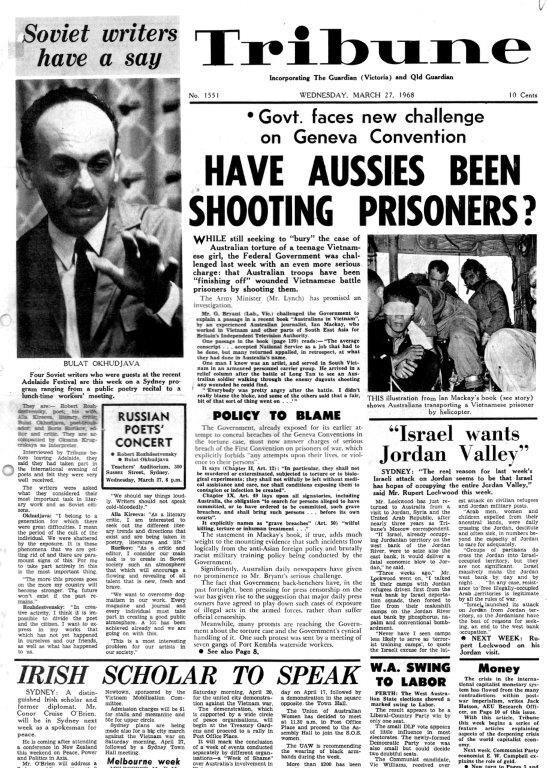
Australian soldiers were accused of war crimes

The Vietnam Moratorium combined students, workers and many others
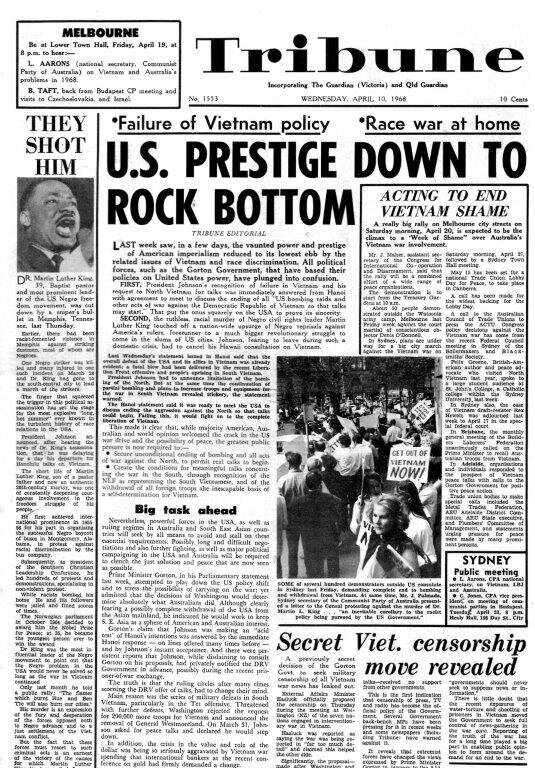
By the end of the war America's reputation in Australia had suffered a severe setback

The Vietnam Moratorium movement and Save our Sons (SOS) were the basis of the magnificent fight against Australia's involvement in the Vietnam War
Eyewitness account of the Moratorium March of May 8 1970
There had been nothing like it in Melbourne since VE day: a concourse of people so vast that the city centre was wholly occupied. The traffic stopped, the shops closed; for a whole afternoon the city returned to one of its traditional functions – a place where pedestrians could define their own needs and purposes. (I. Turner, Room to Manoeuvre, p 154)
Indigenous Struggle
In March 1966 the Conciliation and Arbitration Commission decided that Aboriginal pastoral workers were to receive equal wages but the industry was not required to comply until December 1968. In August 1966 Gurindji pastoral workers, led by Vincent Lingiari, walked off the British owned Wave Hill cattle station in the Northern Territory. The workers camped at Daguragu (Wattie Creek).
What was initially a strike over low wages and appalling living conditions became a struggle for land rights.
CPA members had been active around Aboriginal issues since the party's foundation. Now the CPA played a critical role, using its considerable influence to mobilise and educate a broad and active support base for the Gurindji. Prominent among these activists were Darwin CPA members and union stalwarts Brian Manning and George Gibbs. Two communists, Frank Hardy and Hannah Middleton, wrote about the walkoff, helping to publicise and popularise the Gurindji struggle.
During this struggle, Brian Manning and his J Series Bedford truck, which is now heritage listed, supported the striking workers camped at Daguragu by running supplies from Darwin.
However, the Cold War and anti-communism were still influential. Many in government and the cattle industry were racist and refused to believe that Aboriginal people could organise a strike on their own. Describing the people at Daguragu as tools in the hands of manipulative political agitators also gave the government an excuse to dismiss their demands.
The struggle lasted for nine years until in 1975 then Prime Minister Gough Whitlam handed over a parcel of land to the Gurindji people.
The success of the Gurindji land claim was a real victory against a powerful industry and a hostile government. Without their courage and determination, the ongoing struggle for land rights would be far less advanced.
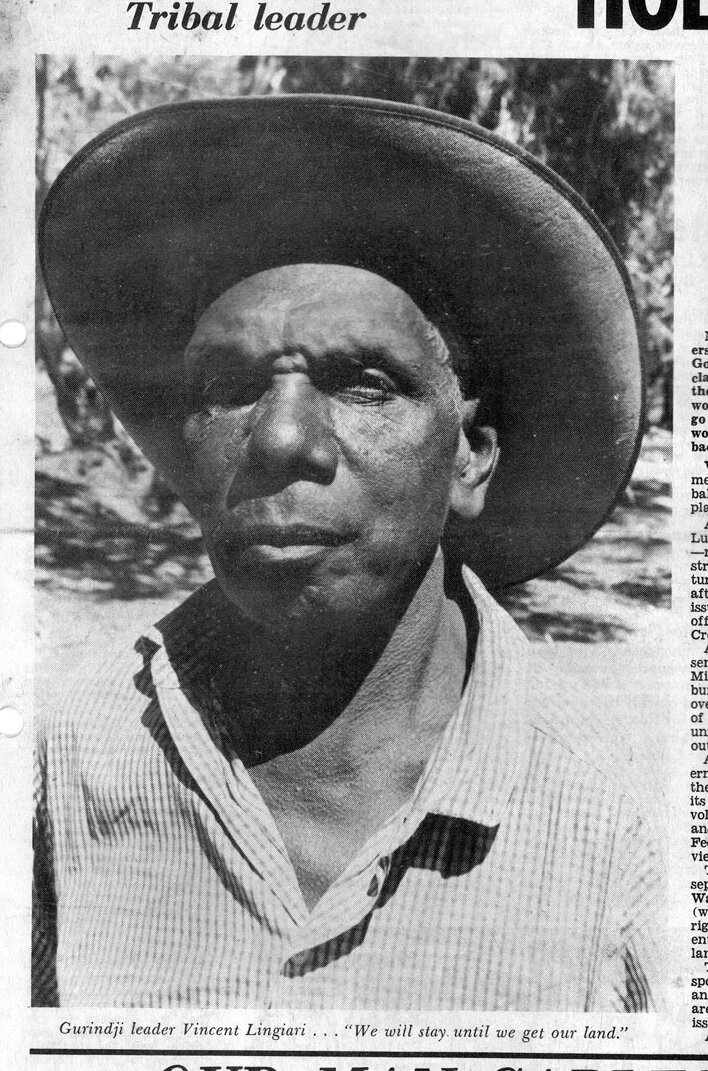
Vincent Lingiari was an elder and leader of the Gurindji Land Rights campaign

The Bedford truck which was driven to Daguragu with supplies from the WWF and the Communist Party in Darwin

Part of the track the Gurindji followed in their famous walk off from Wave Hill Station to their land at Daguragu
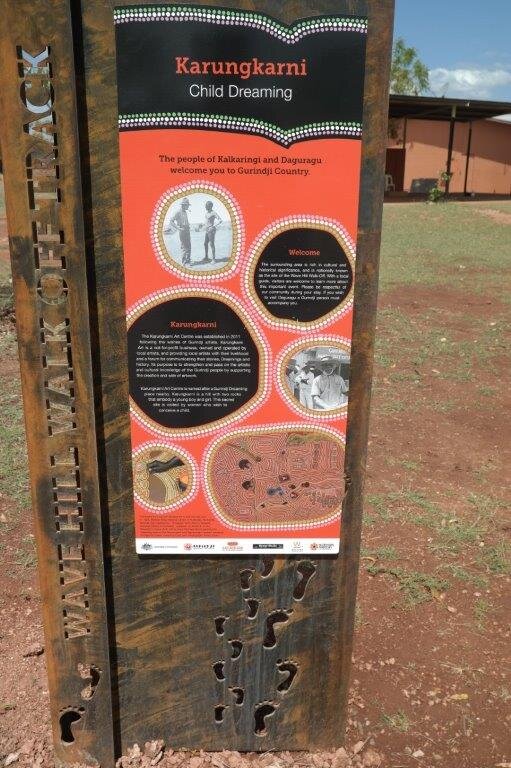
A marker on the walk off trail
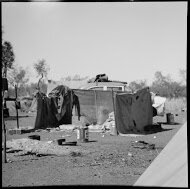
One of the earliest shacks at Daguragu in 1966

At celebrations of the 50th anniversary of the walk off. L-R MUA Sydney Secretary Paul McAleer, author and activist Dr. Hannah Middleton, MUA Sydney Organiser Paul Keating - all members of the Communist Party of Australia.
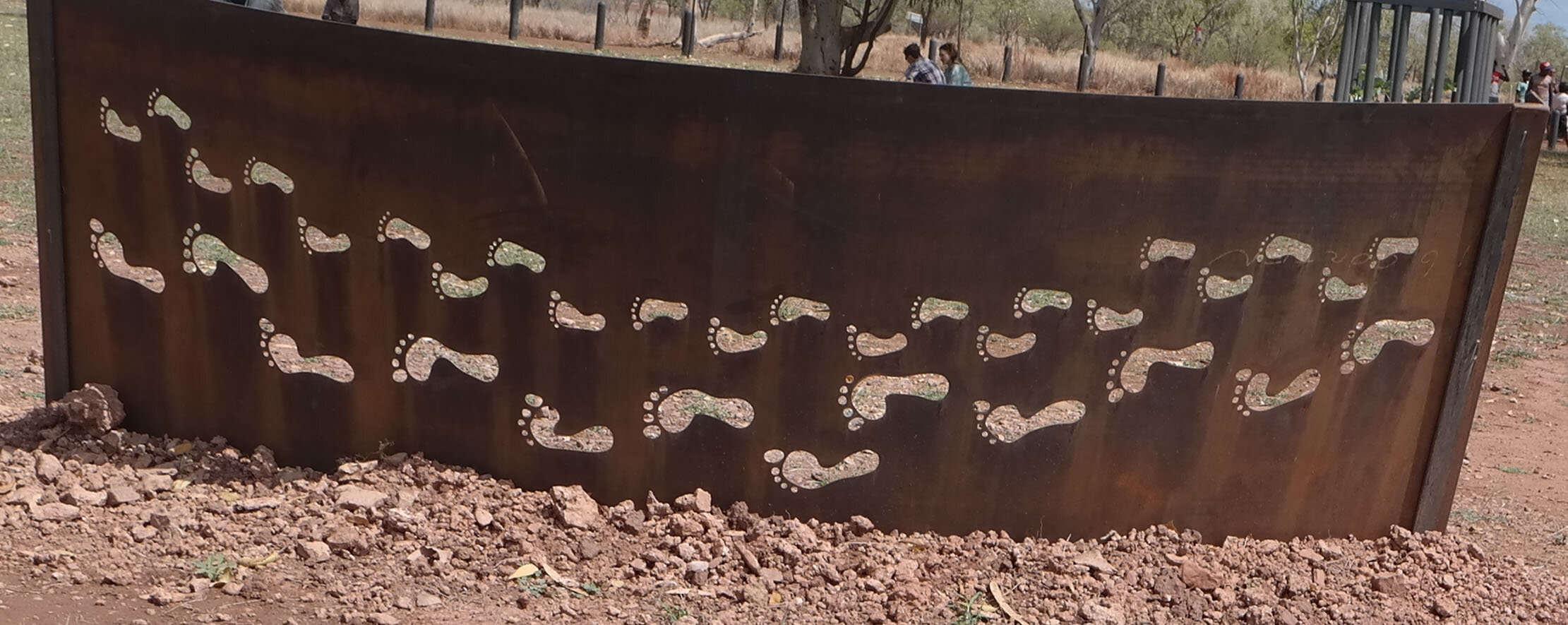
The land rights struggle was greatly advanced by this walk off and strike
Dissension in relation to Czechoslovakia
The developing conflict within Czechoslovakia and intervention by the Soviet Union in August 1968 created confusion and disagreement among Australian Communists.
The Aarons group in the CPA adopted an anti-Soviet position and developed Euro Communism as the official party line. This brought about a split in the CPA that resulted in the formation of the Socialist Party of Australia (SPA) in 1971.
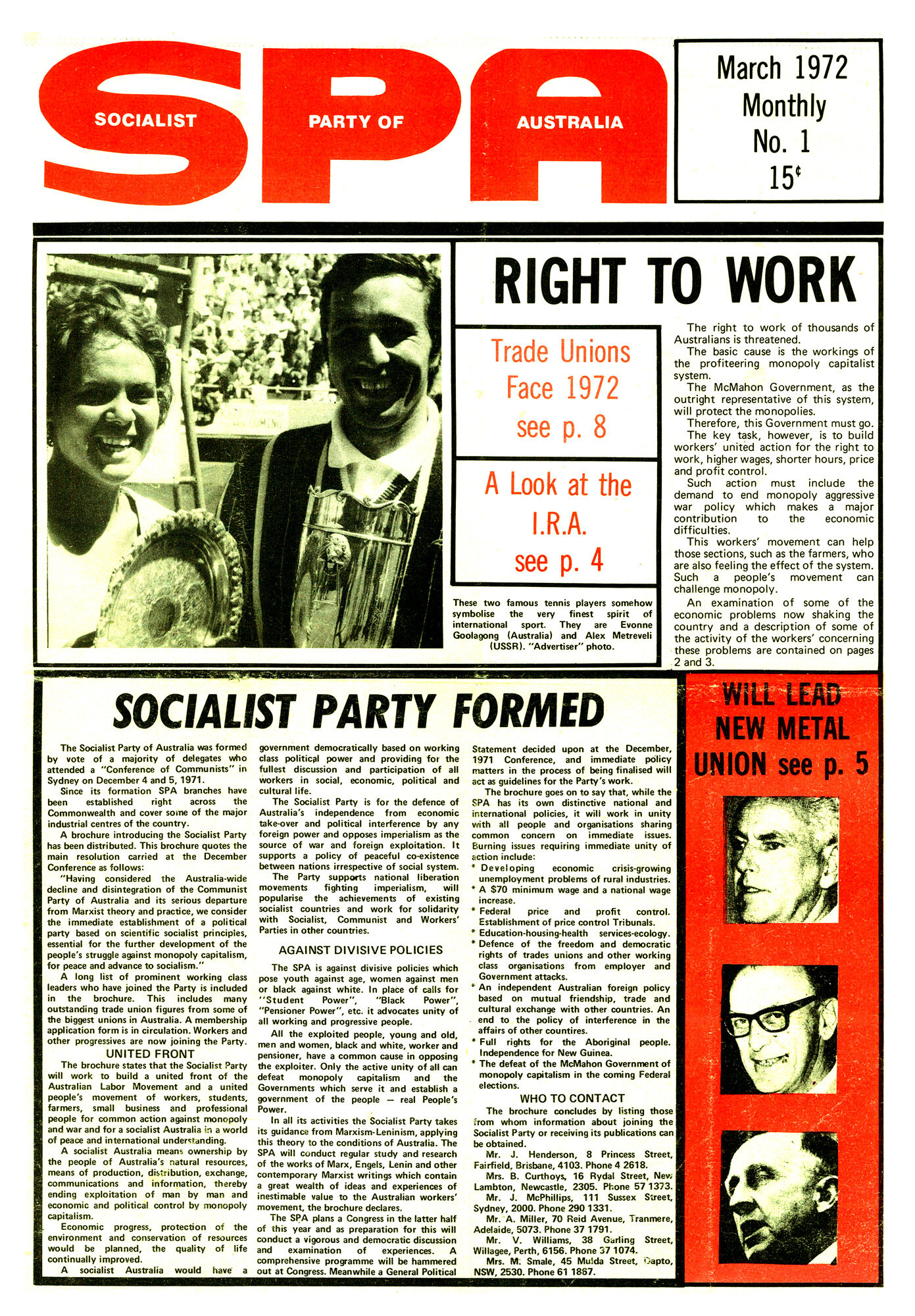
1970s
Whitlam Government and its Dismissal
East Timor
Green Bans
Start of the SPA
Start of the 2nd Communist paper
Chile
Whitlam Government and Dismissal
The Whitlam Government was elected after 23 years of conservative government. Gough Whitlam was elected on a popular promise of change with the slogan ‘its time’. He achieved reforms in social areas including education, family law and Aborigines. He questioned the role of the US war base at Pine Gap. The forces of reaction conspired with the US to have him sacked in a most dramatic way on November 11, 1975.
Prime Minister Gough Whitlam and Vincent Lingiari
Gough Whitlam pouring soil into the hand of traditional landowner Vincent Lingiari, Northern Territory 1975.
PIne Gap near Alice Springs
Whitlam demanded more knowledge and control of Pine Gap, the huge US surveillance and war fighting base in the centre of Australia. This was one of the major reasons why the US intervened to ensure that he and his government were ousted in a bloodless coup.
East Timor - Timor Leste
Indonesia invaded East Timor in December 1975. Then began a protracted armed struggle led by Fretilin, the Revolutionary Front for an Independent East Timor.
Brian Manning, a Communist from Darwin, formed the Darwin branch of the Campaign for an Independent East Timor (CIET) with Robert Wesley-Smith and other activists.
CIET activists provided Fretilin with radio transceivers in late 1975. When Indonesia invaded, Radio Maubere became the main Fretilin link to the outside world and the source of information about the situation in East Timor. It functioned until late 1978.
In a period in which Indonesia kept East Timor closed to the outside world, the radio link provided information on ongoing Fretilin resistance and the very serious humanitarian and human rights situation during the Indonesian invasion and occupation.
Brian Manning at his radio in the bush near Darwin
The Anti-Apartheid Campaign - Springboks
“…the all-white, racially selected, Springboks football team arrived. ….The old Australian passion for sport combined with the new-found hatred of racism to inspire massive demonstrations against apartheid whenever the team appeared… Brawls, broken heads and bad language were most plentiful in Queensland where the Country Party Premier, Mr. Bjelke-Petersen, declared a state of emergency and sent large numbers of aggressive policemen to the football matches.” (R. Ward, A Nation for a Continent, pp 396-7)
The Green Bans
The Green bans were a remarkable form of environmental activism initiated by the builders labourers who refused to work on projects that were environmentally or socially undesirable. This green bans movement was the first of its type in the world.
In May 1970, the executive of the New South Wales Builders Labourers Federation resolved to develop a 'new concept of unionism' encompassing the principle of the social responsibility of labour: that workers had a right to insist their labour not be used in harmful ways.
The union was led by three outstanding men: Jack Mundey, Joe Owens and Bob Pringle. Mundey and Owens, along with about 100 of the union's most committed activists, were members of the Communist Party of Australia.
In a letter to the Sydney Morning Herald in January 1972, Mundey wrote:
Yes, we want to build. However, we prefer to build urgently-required hospitals, schools, other public utilities, high-quality flats, units and houses, provided they are designed with adequate concern for the environment, than to build ugly unimaginative architecturally-bankrupt blocks of concrete and glass offices… The environmental interests of three million people are at stake and cannot be left to developers and building employers whose main concern is making profit. Progressive unions, like ours, therefore have a very useful social role to play in the citizens' interest, and we intend to play it.

A portrait of Jack Mundey in the 1970s

A poster celebrating the saving of the Glebe Estate

Cartoon asks the question: who were the real wreckers? Answer: the developers and the State Government

A partial list of the buildings and other items saved by the Green Bans
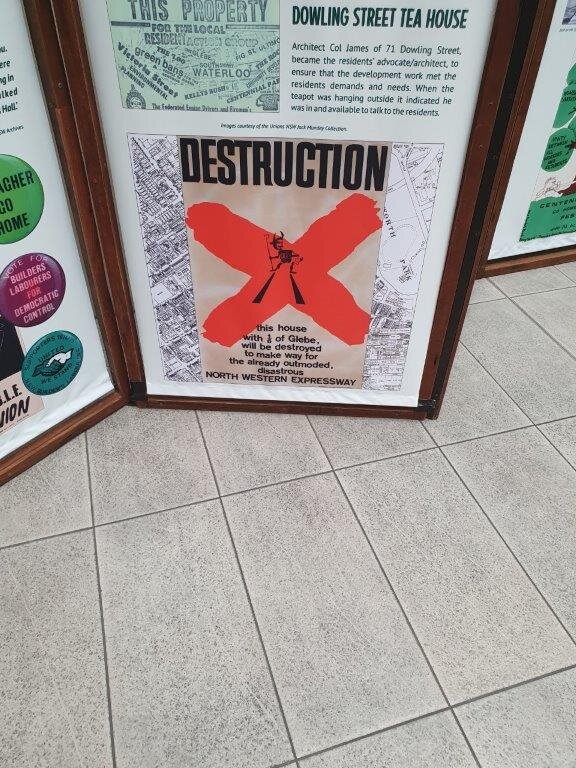
Putting a stop to the destruction of a heritage home in Glebe

The Jack Mundey exhibition held in the NSW Trades Hall, Sydney, October 2020
Foundation of the Socialist Party of Australia (SPA)
General Secretary Peter Symon speaks about why the Socialist Party of Australia was formed.
I think there were a number of reasons and not all of them were clear cut at that time and maybe different people will give you different answers to this question including different members in the SPA who viewed things in one way or another. But we sensed at that time that the Communist Party of Australia was adopting a course which really was taking it away from socialism and away from being a Communist Party. This was expressed in various ways – their attitude towards democracy which we saw as very limited and really an acceptance of the idea that the pinnacle of democracy was what we had in bourgeois society. Well we thought that was a very limited approach. We also did not agree with a number of policies that were being put forward by the Communist Party at that time towards the international communist movement. It was leading to a situation of isolation of the party in that movement. In other words, it was an abandonment of their internationalist obligations. We felt they were moving away from the working class and towards a sort of student academic orientation. In fact, it was said in that period that the working class had now been incorporated into the capitalist system. They could no longer be regarded as the basis of a revolutionary movement in Australia and that the leaders of any revolutionary movement were now students and academics. Whilst it was not seen clearly at that time that these would lead eventually to the liquidation of the Communist Party, I think it would be true to say that many saw it as a substantial departure from what we regarded as Marxist or Communist positions, from socialist positions. But as time went on it did lead to a position in which the Communist Party did in fact liquidate itself, which I think actually proved the point of the criticisms we were making if only in embryo at that time. History has proved us to be right.
The Founding Conference of the Socialist Party was held on December 5, 1971 in Sydney. The Party went on to establish branches in most states and to produce a paper - The Socialist.
Why did the SPA split from the CPA in 1971?
Peter Symon explains


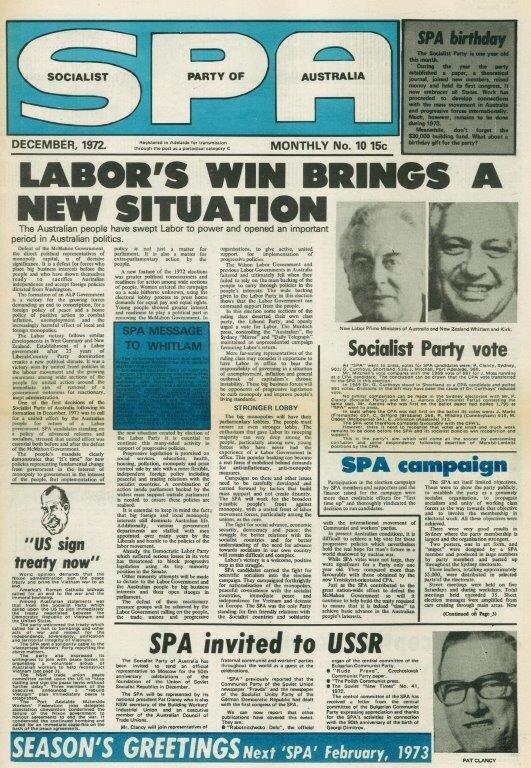

Chile - Resistance to Pinochet Dictatorship
On 11 September 1973, after economic warfare ordered by US President Richard Nixon on the popular Allende Government, a group of military officers led by General Augusto Pinochet and backed by the US staged a bloody right wing coup. His regime was infamous for torture and ‘disappearing’ those thought to be opponents of the Government.
The SPA was active in international solidarity with the democratically elected Chilean Government and the Chilean people. The SPA welcomed into its ranks some of the many Chileans who came to Australia as refugees from Pinochet’s barbarity.
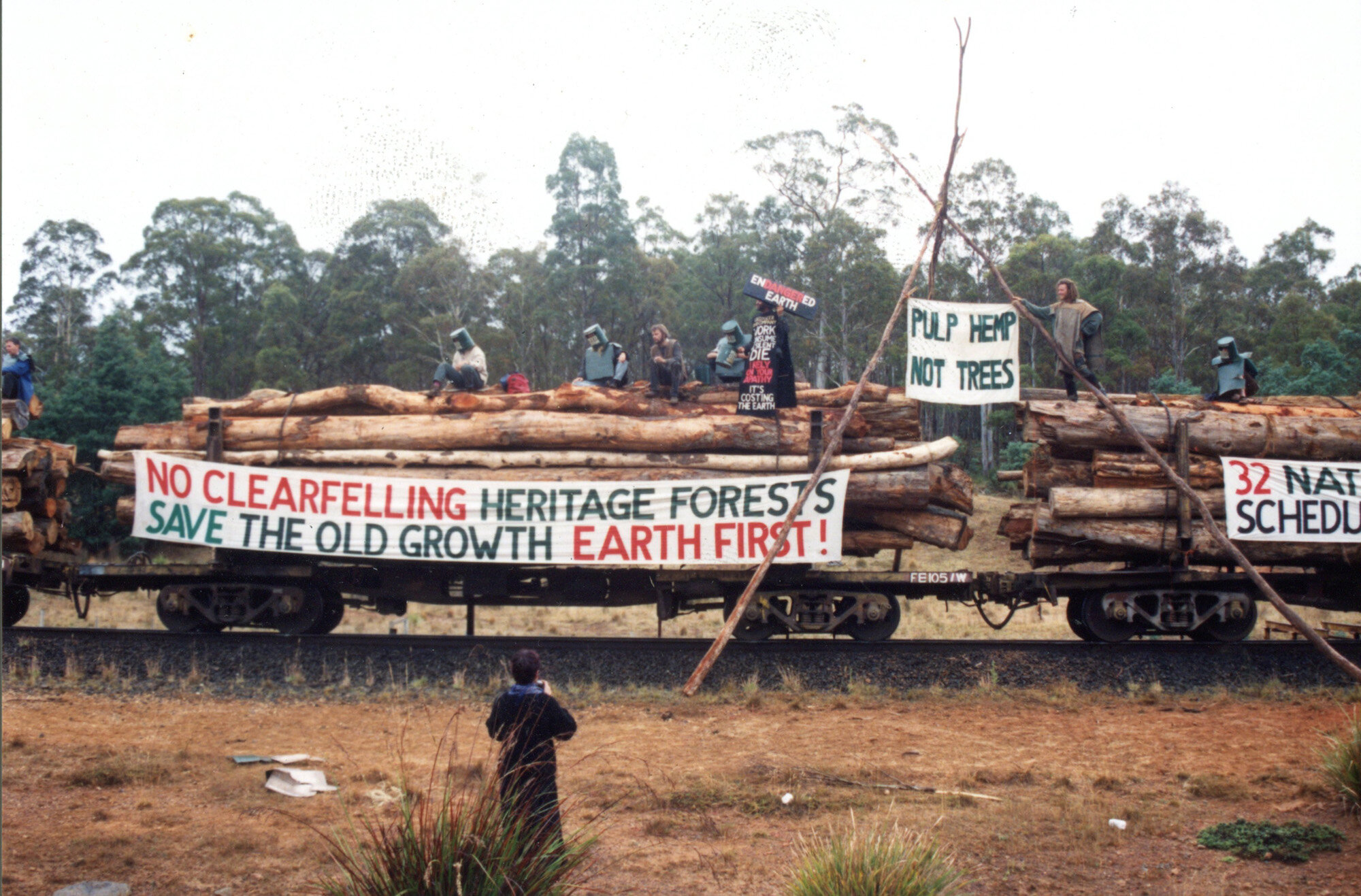
1980s
Peace Rallies
Anti-Bases Protests Begin
Fight against the Accord
At the begining of the 80’s
President Ronald Reagan was in power in the US.
Margaret Thatcher was in power in the UK.
In this period the Margaret Thatcher/Ronald Reagan combination was a powerful force for reactionary forces.
Particularly worrisome was the escalation of the cold war by stationing short range nuclear ballistic missiles in Europe.
The SPA strongly opposed the introduction of the Accord.
The Consequences of the Accord
The real intent of the Prices and Incomes Accord was to disarm the working class ideologically and organisationally so that capitalists could pursue maximum profits with least resistance. (SPA Central Committee member Anna Pha)
Peter Symon addressing a crowd protesting the invasion of Grenada by the USA in October 1983
In Australia in the 80’s
Malcolm Fraser (Liberal) was defeated in the Federal election 1983.
Bob Hawke (ALP) replaced him in 1983.
Paul Keating was Treasurer and later PM when Hawke resigned.
They introduced neoliberal systems and ideas, including privatisation and the Accord.
Actions for pay rises led by the unions never ceased even during a Labor Government time. - Report in the renamed Party paper The Guardian.
A view of the Socialist Party at the 1983 May Day rally
Party support for peace
Peace Rallies
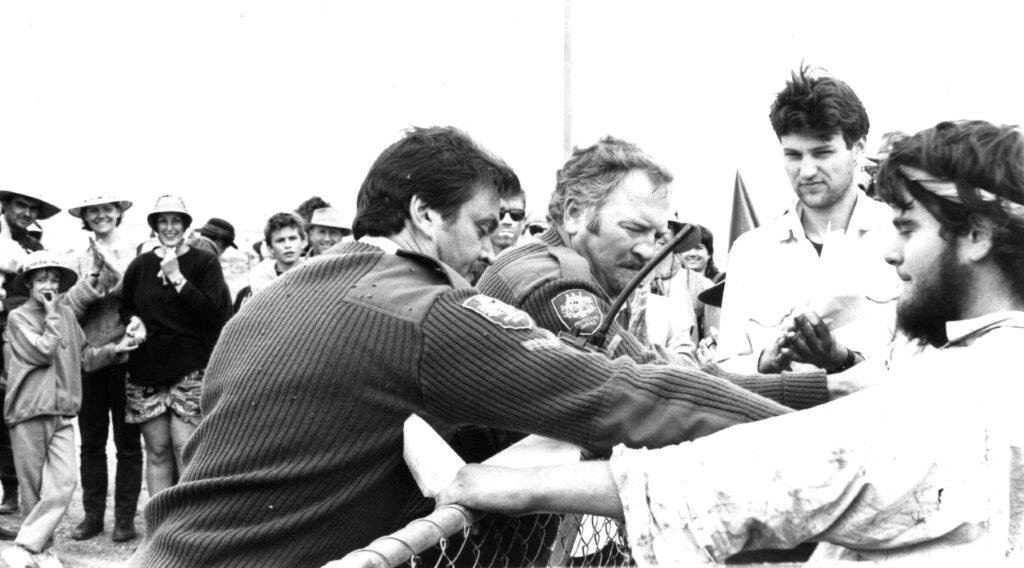
Police pushing back protestors at Nurrungar 1989

Stopping nuclear ship visits to our harbours
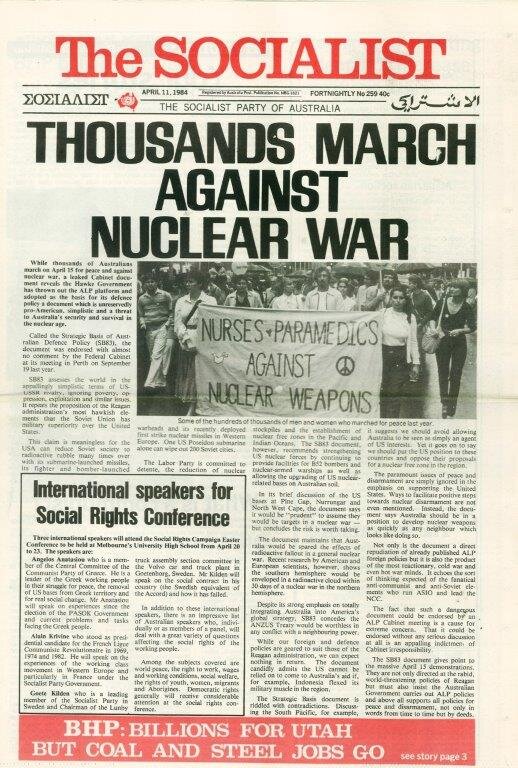
Palm Sunday and Hiroshima marches in the early 80s were huge!
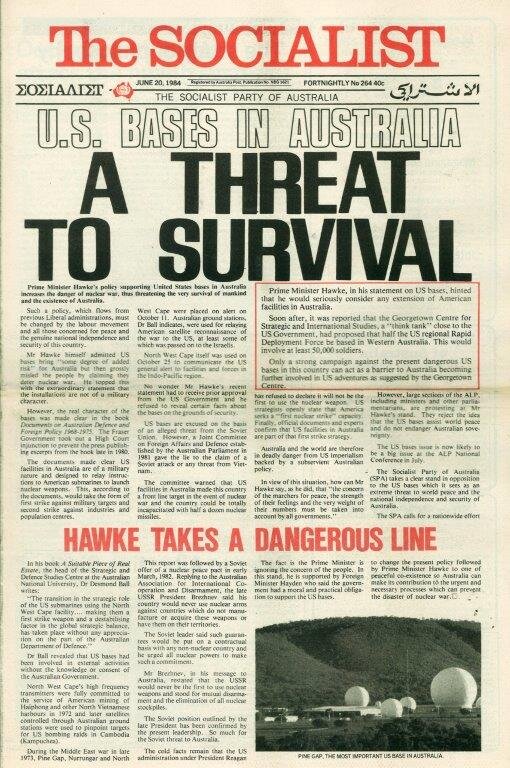
The campaign against US Bases in Australia moves to a new stage

Protesters are informed that the Government is bringing out the troops to protect the US bases
The Foundation of the Anti-Bases Campaign
An inaugural conference in December 1986 in Sydney launched the Australian Anti-Bases Campaign Coalition (AABCC).
In 1987 the AABCC organised a week of action against the US warfighting base at Pine Gap, 20 kms from Alice Springs. Over 2,000 people from all over Australia took part. Below are pictures of the demonstration at Pine Gap.
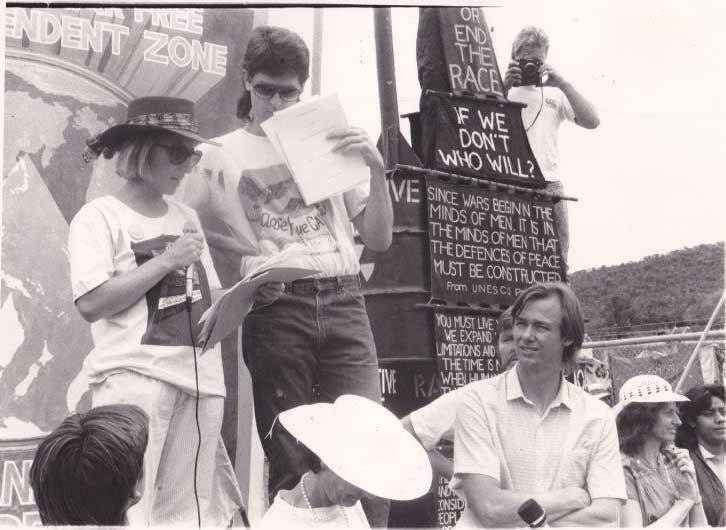
Main platform outside Pine Gap 1987

Some street theatre to demonstrate ramming our way into the base
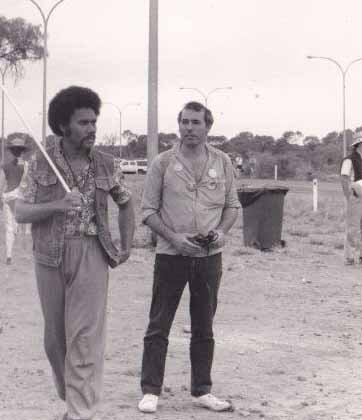
With flag Alphonse Dianou of Kanaky (New Calodonia) who was shot dead by French Commandos a few weeks after returning to his homeland with CPA activist Eddie Clynes
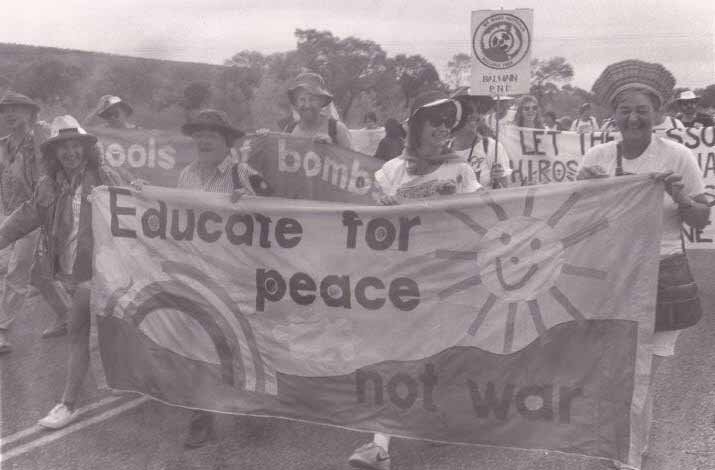
The NSW Teachers Federation representatives at the Pine Gap rally

1990s
The Communist Party of Australia reborn
Iraq War and the fight against sanctions
Mabo Decision
French Testing in the Pacific
MUA Here to Stay Campaign 1997/8
The Communist Party of Australia reborn
Laurie Aarons became the General Secretary of the former CPA in 1965 following the death of Lance Sharkey. … He brought into that position a range of ideas and outlooks which had as their consequence the liquidation of the former CPA in 1991. Obviously his ideas did not stand alone but were or became supported by the majority of the members of the Central Committee and, in time, a majority of the Party’s membership. (SPA General Secretary Peter Symon)
The political decay of the CPA and the loss of so many good comrades was a tragedy for the Australian working class. However, the Socialist Party of Australia took on the role of the Marxist-Leninist Party in this country. In addition some members of the former CPA became active in various social movements.
In an historic step, at its 8th Congress in October 1996, the SPA renamed itself as the Communist Party of Australia.
Campaign Against the Arms Trade - Australian International Defence Exhibition (AIDEX)
At a demonstration in Sydney ‘General Disorder’ turns up with a shopping trolley of armaments.
Protesters Camp near Aidex November 1991
Preparations being made to begin a march on the exhibition site in Canberra
Protesters blocking vehicles entering the Aidex site.
Iraq War and the fight against sanctions
On January 17th 1991 the US military began a huge offensive to drive Iraqi forces out of Kuwait. The US had secretly approved Iraqi leader Saddam Hussein’s move intended to stop Kuwaiti theft of Iraqi oil but now used the situation to intervene in Iraqi affairs. Using every weapon at their disposal from space assisted weaponry to depleted uranium artillery rounds the US drove Iraqi forces out of Kuwait. As the Iraqi military withdrew, they were slaughtered. This stage of the US intervention in Iraq ended on March 3. For Iraq the agony was not over, as the US insisted that Saddam Hussein had weapons of mass destruction, a claim later proved to be a lie. The US imposed sanctions and Iraqi men, women and children suffered severely because the sanctions deprived them of necessities especially medicines.
CPA members around the country were active in growing protests against the war and also waged an ongoing campaign to get the sanctions lifted.
The Mabo Decision
Eddie Mabo
In 1982 Edward Koiki Mabo and four of his fellow Mer Islanders began their legal claim in Australia’s High Court for ownership of lands on the Murray Islands in the Torres Strait. Ten years later in 1991 the High Court decided in their favour. The Mabo Case was significant because it recognised the land rights of the Meriam people, traditional owners of the Murray Islands in the Torres Strait. The case overturned the myth that at the time of colonisation Australia was ‘terra nullius’ or land belonging to no one. The High Court recognised the fact that Indigenous people had lived in Australia for thousands of years and enjoyed rights to their land according to their own laws and customs. The legal doctrine of native title was a landmark moment, it changed the foundation of land law in Australia and the Native Title Act was introduced the following year.
“Many benefits have flowed from the Mabo judgment and the recognition of native title to land – these benefits have been both practical and symbolic. The Mabo judgment was an agent for change and recognition, though many issues of Indigenous recognition and rights remains unresolved.” (Dr Dawn Casey, the Mabo Oration 2015)
Opposition to French nuclear testing grew during the 1990s
Victoria’s Liberal Government destroys the health system
The Patricks Dispute
Magnificent fightback by the MUA and the community to protect union rights
The Australian waterfront dispute of 1998 was an event in Australian industrial relations history when unions and the community came together to defeat the bosses. Major events in the dispute occurred in four major ports where the Patricks Corporation had significant operations: Melbourne, Brisbane, Fremantle and Sydney. The Patricks Corporation, with the support of the Liberal/National Coalition Government, wanted to cut employee numbers and break the power of the Maritime Union of Australia (MUA).
From late 1997, one stevedoring company, Fynwest Pty Ltd, began to recruit members of the SAS and other military specialists to become wharfies. Fynwest planned to send these recruits to Dubai in the United Arab Emirates for training as non-union dock workers. The MUA was tipped off and went to the media. Intense criticism and the threat of international industrial retaliation forced the Dubai Government to cancel the visas for the scabs.
On 8 April 1998, Patricks’ management dismissed all its workers; liquidated its assets, becoming technically insolvent; and imposed a lockout at ports. The Minister for Workplace Relations, Peter Reith, stated that the government fully supported Patricks in their action. By the following morning the docks were fully operational with new scab workers but were surrounded by pickets of community members who responded for many days to the call: MUA Here to Stay!.
The case went to the Federal Court which decided in favour of the union, saying that Patricks had restructured their company with the sole intent to dismiss their unionised workers. The company with the support of the government appealed this decision to the full bench of the Federal Court which upheld the earlier decision. The company then unsuccessfully appealed to the High Court of Australia with the government's support.
The MUA and Patricks negotiated a new work agreement, which was adopted by the company and workers in June 1998.
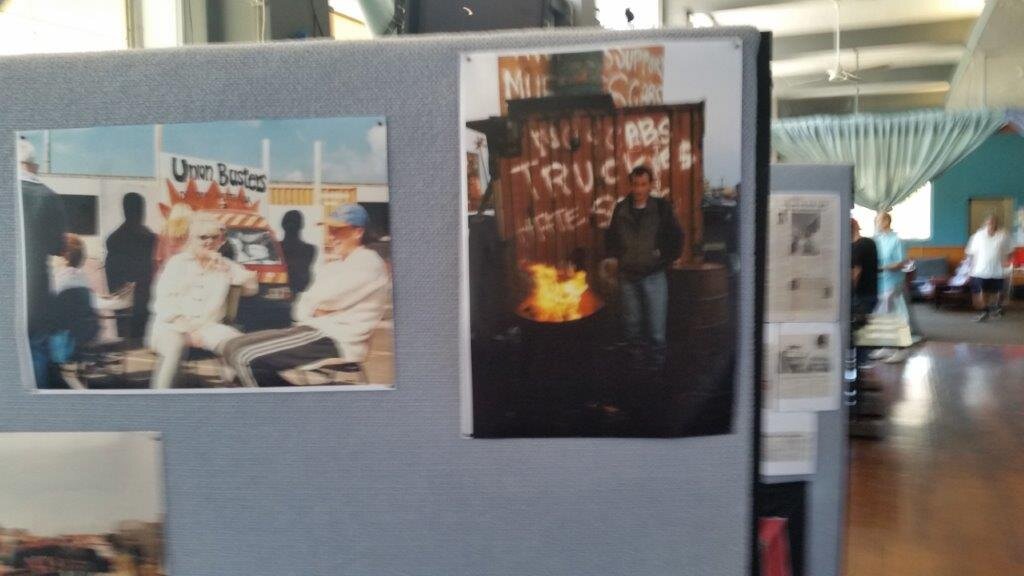
Images from the dispute
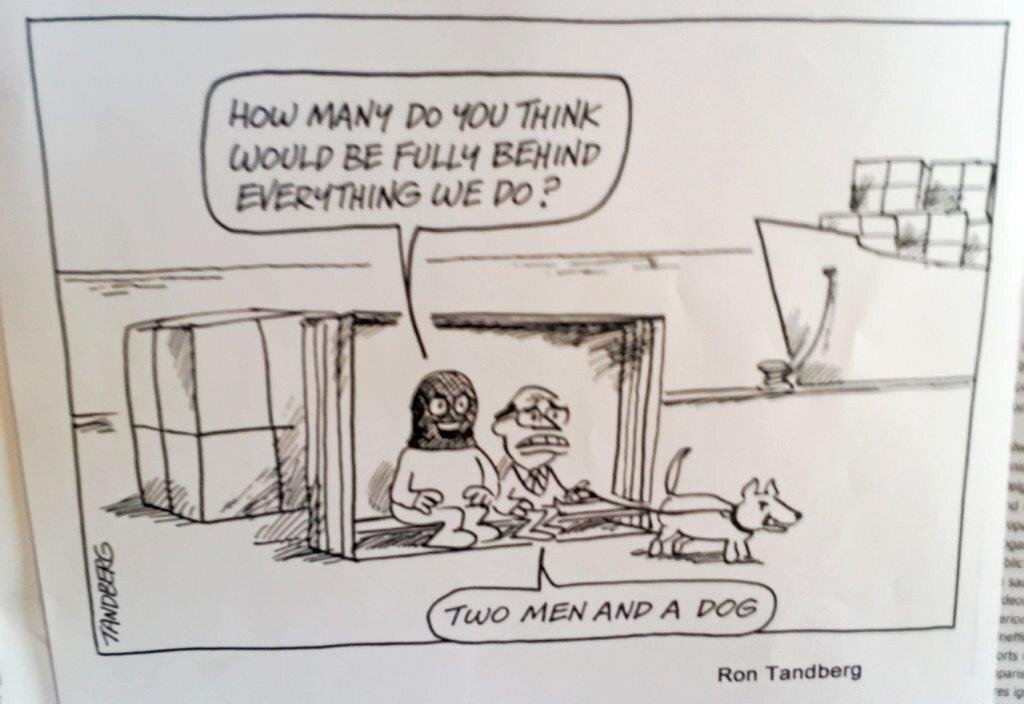
Cartoon about the Patricks dispute

A panel at the 20th anniversary exhibition of the Patricks dispute


































